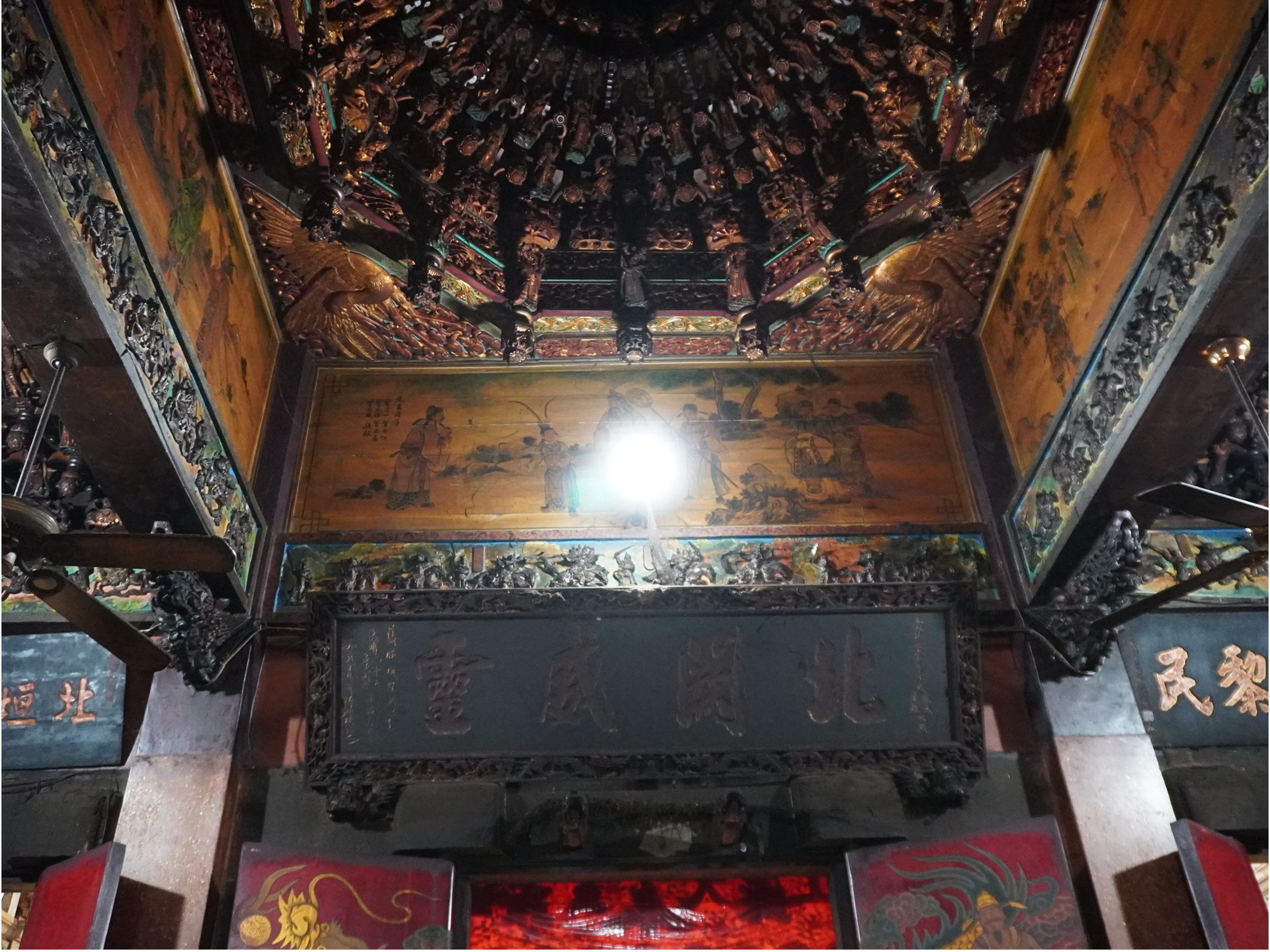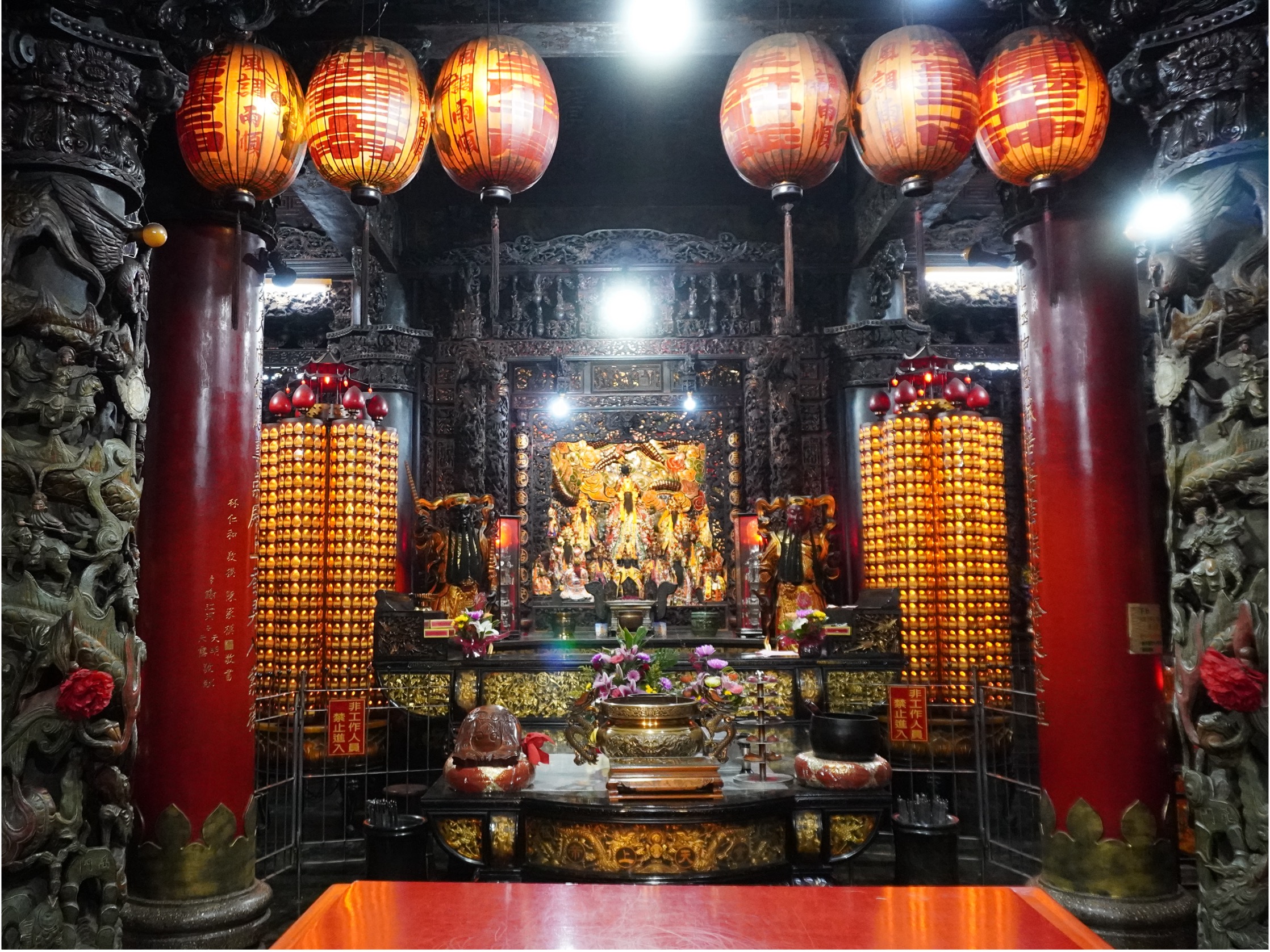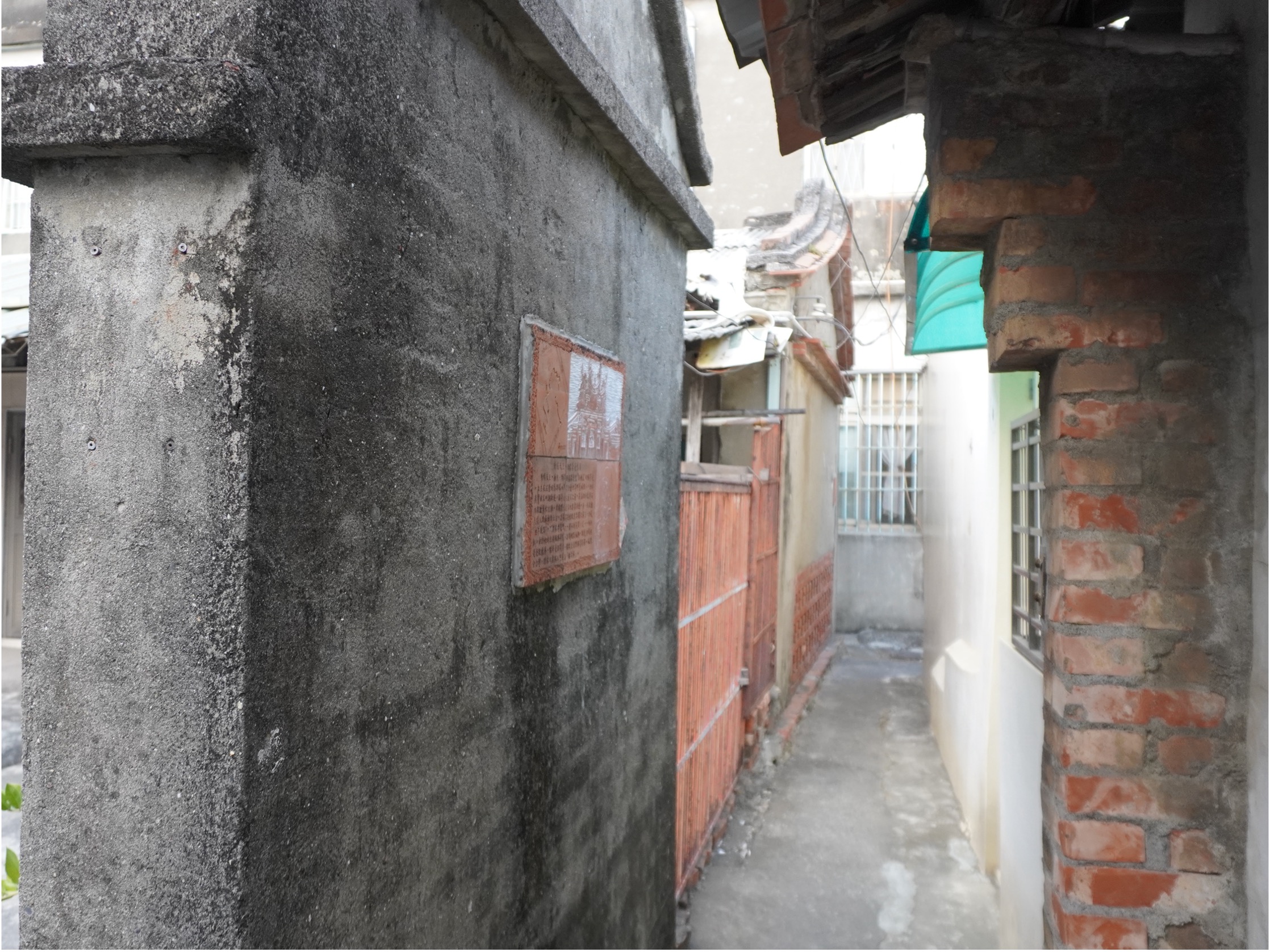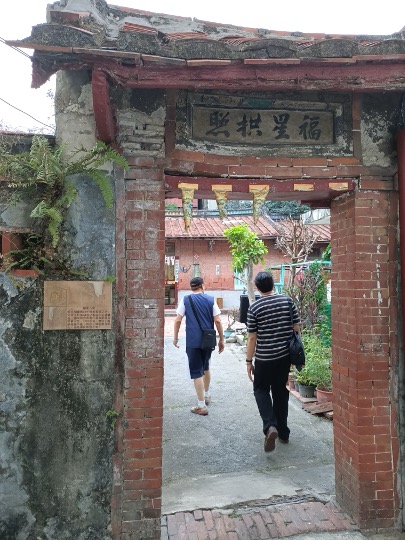The Melody of Time's Meandering: Lotus Pond in Zuoying, Guardianship for Peace and The Heritage of Prosperity – Zuoying Yuandi Temple
文、攝影/柯凱森
在左營地區,擁有著悠久歷史的廟宇和古厝承載著豐富的生活故事,蓮池潭元帝廟更是一座不可忽視的信仰中心,承載著代代相傳的虔誠信仰和動人心弦的故事。為了捕捉這片土地上獨特的文化風貌,在採訪當天有幸採訪到了預官退伍的賴大哥,七旬高齡的他,雖然已退伍多年,仍然保有著不減當年預官體魄的身手,且在言談的神情之中,深深的感受到對這塊土地的眷戀與回味。
In the Zuoying area, temples and ancient houses with a long history carry rich life stories. Among them, the Yuandi Temple by the Lotus Pond stands out as an undeniable center of faith, bearing the sincere beliefs and poignant tales passed down through generations. To capture the unique cultural essence of this land, on the day of the interview, we had the privilege of interviewing Mr. Lai, a retired military officer. Despite being in his seventies and having retired for many years, he still possesses the robust physique of his military days. In his expressions and words, one can deeply sense his profound affection and nostalgic reflections for this piece of land.

預退軍官賴大哥帶領著作者穿梭於巷弄間
Mr.Lai guided us through the narrow alleys of ancient houses.
賴大哥帶著我們穿梭在古厝巷弄間,他謙虛地分享自己只是偶爾回來走走,感嘆著時間的飛逝和一切的隨緣。現今他已搬到五塊厝附近,雖然離元帝廟有一段距離,但他時常回來看看這個地方、穿梭著巷弄,細數著宛如昨日的回憶,仿佛在與歷史對話,而我們也跟著一起跟著賴大哥的時光回憶,漫走在這充滿歷史故事與文化深度元帝廟一帶。
Mr.Lai guided us through the narrow alleys of ancient houses, humbly sharing that he only occasionally comes back to stroll around, lamenting the swift passage of time and the unpredictable nature of everything. Although he has now moved to the Wukuaicuo, a bit away from the Yuandi Temple, he often returns to visit this place, weaving through the alleys, recounting memories that feel as if they happened just yesterday. It's like engaging in a dialogue with history, and we, too, find ourselves immersed in Mr. Lai's nostalgic journey, wandering in the area around the Yuandi Temple, filled with historical stories and cultural depth.
巷弄兩旁的古老建築,顯得歲月的沉澱,卻也透露出一種宛如時光隧道的寧靜。我好奇地問賴大哥,這些古厝是否也和元帝廟有著密不可分的連結。
The ancient buildings lining the alleys, marked by the sedimentation of time, exude a serene atmosphere reminiscent of a time tunnel. Curiously, I asked Brother Lai if these ancient houses also share an inseparable connection with the Yuandi Temple.
他邁著輕快的步伐、連聲笑語的說起,開始述說著元帝廟的歷史。原來,元帝廟建立於清代嘉慶年間,至今已有數百年的歷史。這座廟宇不僅是地方信仰的象徵,更承載著許多居民的家族情感。賴大哥滿懷敬意地描述了當地人對元帝的虔誠,以及廟宇在歷史上所扮演的角色。
With brisk steps and laughter, he enthusiastically began recounting the history of the Yuandi Temple. Apparently, the temple was established during the Jiaqing era of the Qing Dynasty and has a history spanning several centuries. The temple not only symbolizes local faith but also carries the emotional ties of many residents' families. Mr. Lai respectfully described the locals' devout worship of Yuandi and the role the temple has played throughout history.
「這裡是當地村民們祈求風調雨順、五穀豐收的聖地。每逢節慶、以及上帝爺公的聖誕,村民們都會絡繹不絕地湧入廟埕,共同參與虔誠的宗教儀式,祈祝在的的村民,以及外出打拼游子的平安」賴大哥的聲音帶著一絲沉思,彷彿他正在回味著那段悠遠的時光,隨著他的神情,彷彿我也曾是在那元帝廟前長大的孩子一般,感受著節慶的祝福與熱鬧,回味無窮。
This is a sacred place where villagers pray for favorable weather and abundant harvests. During festivals and the birthday celebration of the deity, villagers flock to the temple grounds, participating in religious ceremonies to pray for the well-being of the villagers and the safety of those who venture out for work," Mr. Lai's voice carried a hint of contemplation, as if he were savoring that distant time. With his expression, it felt as if I, too, had grown up in front of the Yuandi Temple, experiencing the blessings and festivities of the celebrations, with memories lingering endlessly.
元帝廟軼聞與在地傳說
Anecdotes about North Pole Great Emperor and local tales
左營四甲守護神
元帝廟曾被稱為「北極大帝廟」,俗稱「左營大廟」,供奉的是「玄天上帝」,又被尊稱為「北極大帝」。賴大哥娓娓道來這座廟宇的歷史,它的起源可追溯至明末永曆二十年,鄭成功復台的時期。康熙五十三年動土興建,經過多次修建後方改名為「元帝廟」。這座廟宇由於法力高強,能夠驅妖治病,因而受到道教信徒的崇信,成為左營居民的守護神,由於位處於舊時的「四甲」,因位於中心地帶,對於當地廟宇的發展更有著重要的深層意義。
The Yuandi Temple, formerly known as the "North Pole Great Emperor Temple" and commonly referred to as the "Zuoying Grand Temple," venerates the "Xuantian Shangdi," also known as the "North Pole Great Emperor." Mr.Lai eloquently narrated the history of this temple, tracing its origins back to the 20th year of the Ming Dynasty's Yongli era during the period of Zheng Chenggong's Taiwan recovery. Construction began in the 53rd year of the Kangxi era and, after multiple renovations, it was eventually renamed the "Yuandi Temple." Due to its powerful spiritual influence, capable of exorcizing demons and curing ailments, the temple gained devout followers in Taoism, becoming the guardian deity of Zuoying residents. Positioned in the old "Fourth Jia " central area, it holds significant and profound meaning for the development of local temples.
在這個地方傳說中,玄天上帝是一位屠夫,為了表示修道的決心,他開腸剖肚將自己的內臟丟入河中洗罪升天成神,被封為玄天上帝,俗稱作「上帝公」。屠夫升天成了上帝公,但沒想到留在人間的腸和胃就變成了妖精,胃化成龜,腸化成蛇,在人間危害萬靈。上帝公知道了他的胃和腸居然變成了龜精和蛇精,非常生氣,於是他就向呂洞賓借來了七星寶劍,下凡來收服了龜精和蛇精,並且把烏龜和蛇踩在腳底下,讓他們永遠不敢造反哦,而上帝公手中也就拿著那把七星寶劍,坐在蓮池潭的水中央了!或許這把七星寶劍一直沒有歸還呂洞賓,現在佇立蓮池潭的巨大玄天上帝神像,可是東南亞最高的水中神像,將烏龜和蛇踩在左腳底下,右腳翹起二郎腿,這與其他地方看到的玄天上帝將烏龜和蛇分別踩在兩隻腳下的樣子不同。
Legend has it that Xuantian Shangdi, initially a butcher, demonstrated his commitment to cultivation by disemboweling himself and washing his internal organs in a river to atone for sins, ascending to godhood as Xuantian Shangdi or colloquially known as the "God of Heaven." However, the remaining intestines and stomach transformed into malevolent spirits—a turtle and a snake—posing threats to all beings. In response, Xuantian Shangdi, wielding the Seven-Star Sword borrowed from Lu Dongbin, descended to subdue the turtle and snake. He stepped on them, ensuring they would never rebel. The statue of Xuantian Shangdi in the middle of the Lotus Pond, holding the Seven-Star Sword, stands as the tallest water deity statue in Southeast Asia, with the turtle and snake beneath his left foot and the right foot raised in a unique pose, unlike depictions seen elsewhere.
另一個左營奇談則說這個降伏的烏龜和蛇就是左營舊城的龜山和蛇山。龜山在龍虎塔旁邊,小龜山是頭部,與大龜山則是的身體,是勝利路開過去的位置,據說當時開路切斷了大小龜山,讓蓮池潭的水都變成了紅色。蛇山則起伏不明顯,大概是在南門往鼓山路那一帶,若從半屏山高處往下看或許蜿蜒起伏的蛇山可以看得比較明顯。玄天上帝下凡降服而成為常相左右的腳力,左倚龜山,右聯蛇山的故事,讓人不禁對玄天上帝的神威感到崇敬。
Another intriguing tale from Zuoying suggests that the subdued turtle and snake represent the Turtle Hill and Snake Hill of the old Zuoying city. Turtle Hill is located beside the Dragon and Tiger Pagodas, with Small Turtle Hill as the head and Big Turtle Hill as the body, severed by the construction of Victory Road, which reportedly turned the waters of the Lotus Pond red. Snake Hill's undulating terrain is less distinct, possibly in the area near South Gate and Gu Shan Road. The story of Xuantian Shangdi descended to earth, leaning against Turtle Mountain and connecting with Snake Mountain, evokes a deep sense of reverence for the divine power of Xuantian Shangdi.

元帝廟內部的天花板與壁畫
Ceiling and Wall Paintings of North Pole Great Emperor Temple

玄天上帝神像
Statue of North Pole Great Emperor
藝人豬哥亮與老家謝家古厝
Zhu Geliang's old residence, the Xie Family Ancient House
左營在地傳奇人物
訪談中,賴大哥不僅分享了元帝廟的歷史和神話故事,更讓我們深入了解這片土地的文化底蘊。他興奮地提到,著名藝人豬哥亮過去曾常回來在元帝廟前找朋友聊天泡茶,將我們帶到了豬哥亮的老家謝家古厝。
In the interview, Mr.Lai not only shared the history and mythological stories of the Yuandi Temple but also provided us with a deeper understanding of the cultural richness of this land. He excitedly mentioned that the renowned Taiwanese entertainer, Zhu Geliang, used to come back often to chat and have tea with friends in front of the Yuandi Temple, leading us to Zhu Geliang's old residence, the Xie Family Ancient House.
這座古厝,目前已不見人影,門口則記錄了豬哥亮與這片土地交織的點點滴滴,我覺得或許這也是在古厝探訪的旅程中,每每總是處處皆有精彩故事的感動吧。
The ancient house, currently devoid of human presence, bears witness at its entrance to the various moments intertwined between Zhu Geliang and this land. I couldn't help but feel that, perhaps, this is the emotional resonance one experiences during a journey of exploring ancient houses—a sense that everywhere holds captivating stories.

豬哥亮舊居說明牌
Instruction board of renowned Taiwanese entertainer, Zhu Geliang
這次的訪談匯集了元帝廟的歷史、神話故事,以及賴大哥的親身經歷,將這片土地的文化傳承凝聚成一個豐富的故事。在他的引領下,我們彷彿跟隨著他的步伐,一同穿越了時空,聽見了那時穿梭巷道的精采,也看見了歲月往來人們的軌跡。這個故事,不僅是地方文化的傳承,更是賴大哥與這塊土地走過時光的見證。
This interview has brought together the history of the Yuandi Temple, mythological stories, and Mr. Lai's personal experiences, weaving them into a rich narrative that encapsulates the cultural heritage of this land. Guided by him, it feels as though we are following in his footsteps, traversing through time and space. We hear the vibrant tales that once echoed through the alleys and witness the imprints of time on people's journeys. This story is not only the inheritance of local culture, but also a testimony of the time that Brother Lai has spent with this land.

豬哥亮舊居說明牌鑲於牆上
Instruction board of Zhu Geliang hung on the wall
「年輕人需要知道自己的根,才能茁壯成長。過去不需要地圖而可以在巷弄間行走不會迷路,巷子裡面都是人,走久了多半也認得會打招呼。像現在很多地址在手機地圖上還不見得看到,怎麼走都還搞不清楚方向」賴大哥語重心長地說著,感嘆多數已經人去樓空,人情味不在,只剩下在展覽館看圖說故事。我們跟隨著賴大哥穿梭在古厝巷弄走了一下午,他繼續向我展示了一座座古老的建築,每一座宅邸都有著自己的劇情。我們仿佛被帶回到過去,感受到這塊土地積累的歷史。
“Young people need to know their roots to thrive and grow. In the past, we didn't need maps to navigate through the alleys without getting lost. Every corner was filled with people, and after walking for a while, you would likely recognize and exchange greetings with familiar faces. Nowadays, many addresses may not even be found on mobile maps, making it confusing to figure out directions," Mr.Lai said earnestly, expressing his lament for the diminishing sense of community, with many places now empty, replaced by exhibitions and storytelling in museums. We spent an entire afternoon wandering through ancient house alleys with Mr. Lai, as he continued to showcase various old buildings, each with its own unique story. It felt as if we were transported back in time, experiencing the accumulated history of this land.

舊居與門額
The old house
這次的訪談成為了一次珍貴的探險,跟隨著賴大哥回憶的視野與親身的經歷,我們看到了元帝廟的歷史,感受到了這塊土地的溫暖,隨著千絲萬縷交織的故事,形成了一幅幅豐富且動人的文化瑰寶。
This interview became a precious adventure as we followed Mr. Lai's reminiscences and firsthand experiences. Through his perspective, we witnessed the history of the Yuandi Temple and felt the warmth of this land. Woven together with myriad interconnecting stories, it created a tapestry of rich and poignant cultural treasures.
